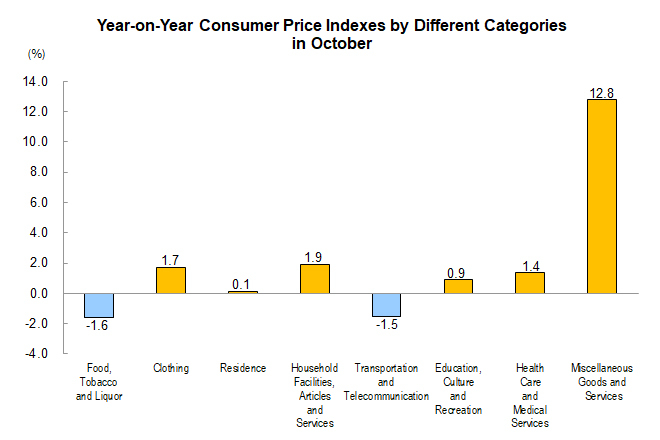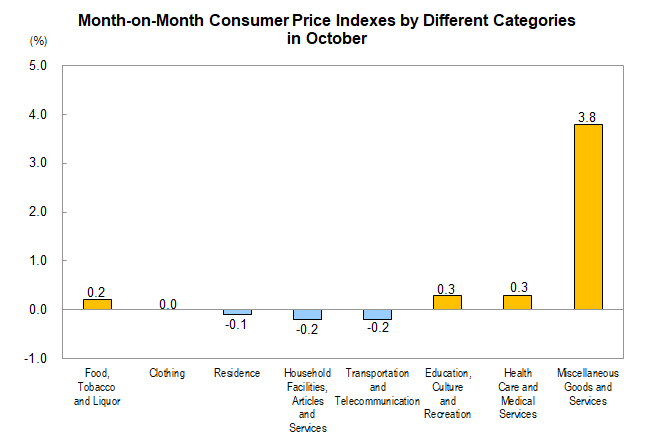Consumer Price Index in October 2025
In October 2025, China’s Consumer Price Index (CPI) increased by 0.2% year on year. Specifically, the price index in urban areas increased by 0.3% while that in rural areas decreased by 0.2%; the price index for food decreased by 2.9% while that for non-food increased by 0.9%; the price index for consumer goods decreased by 0.2% while that for services increased by 0.8%. From January to October, on average, China’s CPI decreased by 0.1% compared with the same period of the previous year.
In October, China’s CPI increased by 0.2% month on month. Specifically, the price indexes in urban and rural areas increased by 0.2% and 0.1%, respectively; the price indexes for food and non-food rose by 0.3% and 0.2%, respectively; the price indexes for consumer goods and services both went up by 0.2%.

I. Year-on-Year Changes in Price Indexes for Various Goods and Services
In October, the price index for food, tobacco and liquor decreased by 1.6% year on year, pushing the CPI down by about 0.46 percentage points. Among food, the price index for eggs decreased by 11.6%, pushing the CPI down by about 0.08 percentage points; that for meat of livestock decreased by 7.4%, pushing the CPI down by about 0.23 percentage points, of which the price index for pork decreased by 16.0%, pushing the CPI down by about 0.23 percentage points; that for fresh vegetables decreased by 7.3%, pushing the CPI down by about 0.18 percentage points; that for fresh fruits decreased by 2.0%, pushing the CPI down by about 0.04 percentage points; that for grain decreased by 0.7%, pushing the CPI down by about 0.01 percentage points; and that for aquatic products increased by 2.0%, pushing the CPI up by about 0.04 percentage points.
Among price indexes for the other seven major categories, six increased and one decreased year on year. Specifically, the price indexes for miscellaneous goods and services, household facilities, articles and services, and clothing increased by 12.8%, 1.9%, and 1.7%, respectively; the price indexes for health care and medical services, education, culture and recreation, and residence increased by 1.4%, 0.9%, and 0.1%, respectively; and that for transportation and telecommunication decreased by 1.5%.

II. Month-on-Month Changes in Price Indexes for Various Goods and Services
In October, the price index for food, tobacco and liquor increased by 0.2% month on month, pushing the CPI up by about 0.07 percentage points. Among food, the price index for fresh vegetables increased by 4.3%, pushing the CPI up by about 0.09 percentage points; that for fresh fruits increased by 1.2%, pushing the CPI up by about 0.03 percentage points; that for eggs decreased by 1.7%, pushing the CPI down by about 0.01 percentage points; that for meat of livestock decreased by 0.9%, pushing the CPI down by about 0.03 percentage points, of which the price index for pork decreased by 2.5%, pushing the CPI down by about 0.03 percentage points; that for aquatic products decreased by 0.9%, pushing the CPI down by about 0.02 percentage points.
Among the price indexes for the other seven major categories, three increased, one remained flat, and three decreased month on month. Specifically, the price indexes for miscellaneous goods and services, education, culture and recreation, and health care and medical services increased by 3.8%, 0.3% and 0.3%, respectively; the price index for clothing remained flat; the price indexes for household facilities, articles and services, transportation and telecommunication, and residence decreased by 0.2%, 0.2% and 0.1%, respectively.

Consumer Price Indexes in October 2025
|
|
Growth Rate M/M (%) |
Growth Rate Y/Y (%) |
Jan-Oct |
|
Consumer Price Index |
0.2 |
0.2 |
-0.1 |
|
Of which: Urban |
0.2 |
0.3 |
0.0 |
|
Rural |
0.1 |
-0.2 |
-0.3 |
|
Of which: Food |
0.3 |
-2.9 |
-1.9 |
|
Non-food |
0.2 |
0.9 |
0.3 |
|
Of which: Consumer goods |
0.2 |
-0.2 |
-0.5 |
|
Services |
0.2 |
0.8 |
0.5 |
|
Of which: Excluding food and energy |
0.2 |
1.2 |
0.7 |
|
By categories |
|
|
|
|
I. Food, tobacco and liquor |
0.2 |
-1.6 |
-0.9 |
|
Grain |
0.0 |
-0.7 |
-1.1 |
|
Edible oil and fats |
0.2 |
-1.1 |
-1.7 |
|
Fresh vegetables |
4.3 |
-7.3 |
-7.8 |
|
Meat of livestock |
-0.9 |
-7.4 |
-3.2 |
|
Of which: Pork |
-2.5 |
-16.0 |
-4.3 |
|
Beef |
0.5 |
5.6 |
-2.5 |
|
Mutton |
1.3 |
2.4 |
-2.5 |
|
Aquatic products |
-0.9 |
2.0 |
1.3 |
|
Eggs |
-1.7 |
-11.6 |
-6.4 |
|
Milk and other dairy products |
-0.1 |
-1.7 |
-1.5 |
|
Fresh fruits |
1.2 |
-2.0 |
0.9 |
|
Cigarettes |
-0.1 |
-0.1 |
0.2 |
|
Liquor |
-0.1 |
-2.0 |
-1.9 |
|
II. Clothing |
0.0 |
1.7 |
1.5 |
|
Garments |
0.1 |
1.8 |
1.6 |
|
Footwear |
-0.1 |
1.5 |
0.9 |
|
III. Residence |
-0.1 |
0.1 |
0.1 |
|
Rent of rental housing |
-0.1 |
-0.1 |
-0.1 |
|
Water, electricity and fuels |
0.0 |
0.3 |
0.4 |
|
IV. Household facilities, articles and services |
-0.2 |
1.9 |
0.7 |
|
Home appliances |
-0.7 |
5.0 |
1.1 |
|
Household services |
0.1 |
1.6 |
2.0 |
|
V. Transportation and telecommunication |
-0.2 |
-1.5 |
-2.7 |
|
Transport facilities |
-0.1 |
-1.9 |
-3.0 |
|
Fuels for transport facilities |
-0.8 |
-5.4 |
-7.0 |
|
Use and maintenance of transport facilities |
-0.1 |
0.1 |
0.2 |
|
Telecommunication facilities |
0.0 |
1.2 |
0.8 |
|
Telecommunication services |
0.0 |
0.0 |
0.0 |
|
Postal services |
0.0 |
0.1 |
-0.1 |
|
VI. Education, culture and recreation |
0.3 |
0.9 |
0.8 |
|
Education services |
0.0 |
0.7 |
1.1 |
|
Touring |
2.5 |
2.1 |
0.1 |
|
VII. Health care and medical services |
0.3 |
1.4 |
0.6 |
|
Traditional Chinese medicines |
-0.1 |
-0.9 |
-0.1 |
|
Western medicines |
-0.1 |
-1.3 |
-1.2 |
|
Medical services |
0.5 |
2.4 |
1.1 |
|
VIII. Miscellaneous goods and services |
3.8 |
12.8 |
8.0 |
Annotations:
1. Index Interpretation
The Consumer Price Index (CPI) is a relative figure that measures variations in the price level of consumer goods and services over time, comprehensively reflecting changes in prices of consumer goods and services purchased by residents.
2. Statistical Coverage
The statistical coverage of the CPI covers the prices of eight major categories of goods and services purchased by national urban and rural residents, including food, tobacco and liquor, clothing, residence, household facilities, articles and services, transportation and telecommunication, education, culture and recreation, health care and medical services, and miscellaneous goods and services, as well as 268 basic categories.
3. Survey Method
Survey sites are selected through a sampling survey method. In accordance with the principle of “fixed person, fixed site, and fixed time”, statisticians are directly assigned to the survey sites or collect the original prices from the Internet. The data comes from nearly 100,000 survey points from about 500 cities and counties in 31 provinces (autonomous regions and municipalities), covering shopping malls (stores), supermarkets, farmers’ (fresh produce) markets, service outlets, and Internet e-commerce.
4. Data Description
Due to rounding off, the aggregate data may be equal to the high or low value of the classified figures.
